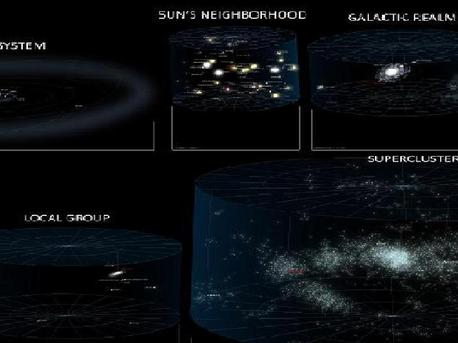Galactic Gangs
Where Are The Nearest Islands Of Stars?
 © Azcolvin (CC-BY-SA 3.0).
|
The images show Earth's position within the local supercluster, from top left to bottom right (left to right in the high-resolution image), five zoom levels / five star maps: 1 - the Solar System 2 - the Sun's neighbouring stars 3 - the immediate vicinity of the Milky Way 4 - the Local Group 5 - the Virgo Supercluster
Star cluster – Galaxy – Galaxy cluster – Supercluster
Our Milky Way and the Andromeda Galaxy are the most massive members of what is known as the Local Group, which also contains around 40 dwarf galaxies. On greater length scales, the Local Group is assigned to the Virgo Supercluster. In the center of the Virgo Supercluster there is the Virgo Galaxy Cluster, which is named after the constellation Virgo. The Local Group is attracted by the large mass of the Virgo Galaxy Cluster and is moving towards it.
Source: German Aerospace Center
Galactic Gangs
Where Are The Nearest Islands Of Stars?
 © Azcolvin (CC-BY-SA 3.0).
|
The images show Earth's position within the local supercluster, from top left to bottom right (left to right in the high-resolution image), five zoom levels / five star maps: 1 - the Solar System 2 - the Sun's neighbouring stars 3 - the immediate vicinity of the Milky Way 4 - the Local Group 5 - the Virgo Supercluster
Star cluster – Galaxy – Galaxy cluster – Supercluster
Our Milky Way and the Andromeda Galaxy are the most massive members of what is known as the Local Group, which also contains around 40 dwarf galaxies. On greater length scales, the Local Group is assigned to the Virgo Supercluster. In the center of the Virgo Supercluster there is the Virgo Galaxy Cluster, which is named after the constellation Virgo. The Local Group is attracted by the large mass of the Virgo Galaxy Cluster and is moving towards it.
Source: German Aerospace Center






